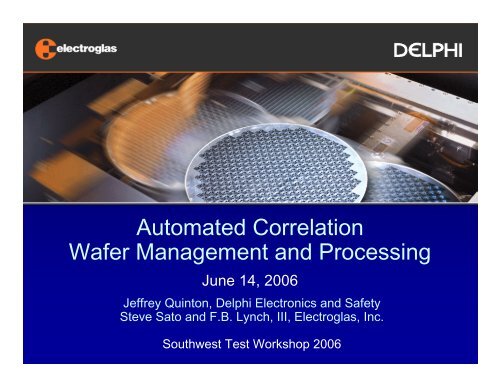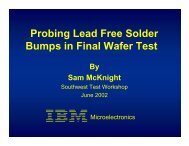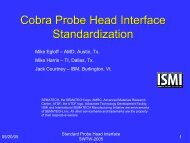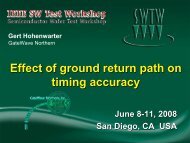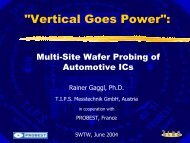Automated Correlation Wafer Management and Processing
Automated Correlation Wafer Management and Processing
Automated Correlation Wafer Management and Processing
Create successful ePaper yourself
Turn your PDF publications into a flip-book with our unique Google optimized e-Paper software.
<strong>Automated</strong> <strong>Correlation</strong><br />
<strong>Wafer</strong> <strong>Management</strong> <strong>and</strong> <strong>Processing</strong><br />
June 14, 2006<br />
Jeffrey Quinton, Delphi Electronics <strong>and</strong> Safety<br />
Steve Sato <strong>and</strong> F.B. Lynch, III, Electroglas, Inc.<br />
Southwest Test Workshop 2006
Presentation Contents<br />
• Who is Delphi Electronics & Safety<br />
• Current <strong>Correlation</strong> <strong>Wafer</strong> Process<br />
– Current <strong>Correlation</strong> Process Concerns<br />
– How Can The Process Be Improved<br />
• What is <strong>Correlation</strong> <strong>Wafer</strong> Manager (CWM)<br />
– How CWM Functions<br />
– CWM <strong>Automated</strong> Map Manager<br />
– CWM Rule Setup Interface<br />
– Examples of CWM Maps<br />
– CWM Prober Messaging<br />
• Conclusions<br />
– Benefits<br />
– ROI - Return on Investment<br />
– ROI Data<br />
SWTW 2006 Jeffrey Quinton, Delphi Electronics <strong>and</strong> Safety; Steve Sato <strong>and</strong> F.B. Lynch, III, Electroglas, Inc. 2
Who Is Delphi?<br />
• Delphi is a world leader in mobile electronics <strong>and</strong><br />
transportation components <strong>and</strong> systems technology<br />
• Multi-national Delphi<br />
– Conducts its business operations through various subsidiaries<br />
<strong>and</strong> has headquarters in Troy, Mich., USA, Paris, Tokyo <strong>and</strong><br />
São Paulo, Brazil.<br />
• Delphi's two business sectors<br />
– Dynamics, Propulsion, Thermal, <strong>and</strong> Interior Sector<br />
– Electrical, Electronics, <strong>and</strong> Safety Sector<br />
• Delphi has approximately 185,000 employees <strong>and</strong><br />
operates 171 wholly owned manufacturing sites,<br />
42 joint ventures, 53 customer centers <strong>and</strong> sales offices<br />
<strong>and</strong> 33 technical centers in 40 countries.<br />
SWTW 2006 Jeffrey Quinton, Delphi Electronics <strong>and</strong> Safety; Steve Sato <strong>and</strong> F.B. Lynch, III, Electroglas, Inc. 3
Delphi Electronics & Safety<br />
Breadth of Product<br />
Body<br />
Powertrain<br />
Safety<br />
Integrated Media Systems<br />
1dd05-16.0<br />
Body Electronics<br />
Climate Controllers<br />
Head-up Displays<br />
Instrument Clusters<br />
St<strong>and</strong>alone & Engine <strong>Management</strong> System<br />
Controllers<br />
•Engine<br />
• Machine <strong>and</strong> Heavy Duty<br />
• Powertrain<br />
• Transmission<br />
Airbags<br />
•Frontal, Side, Curtain<br />
•Inflators, Cushions, Covers<br />
Antilock Brake Control<br />
Belt Tension Sensor<br />
Seat Belts<br />
Steering Wheels<br />
Suspension Electronic Control<br />
Acoustic Systems<br />
Advanced Digital Audio<br />
• Playback Devices<br />
• Satellite Receivers<br />
• Digital Receivers<br />
Amplifiers<br />
Fuba® Advanced Antenna Systems<br />
Security Systems<br />
• Vehicle<br />
•Content<br />
Power Modules<br />
Semiconductors<br />
Software<br />
Forewarn® Collision Warning Systems<br />
• Smart Cruise Control<br />
• Back-up Aid<br />
• Side Alert<br />
Restraint Systems Electronics<br />
•Crash Sensing<br />
• Occupant Sensing<br />
Steering Electronic Control<br />
H<strong>and</strong>s-free Connectivity<br />
Navigation Systems<br />
Premium Audio Systems<br />
Rear Seat Entertainment Systems<br />
Receivers<br />
Satellite Data Services <strong>and</strong> Communication<br />
Truck PC<br />
Wireless Networking<br />
SWTW 2006 Jeffrey Quinton, Delphi Electronics <strong>and</strong> Safety; Steve Sato <strong>and</strong> F.B. Lynch, III, Electroglas, Inc. 4
Delphi Electronics & Safety<br />
Delphi Microelectronics Center<br />
Flip Chip Bumping<br />
Chip Scale Package<br />
Interface Chips<br />
Micro Electromechanical<br />
Systems Electromechanical<br />
(MEMS)<br />
Systems (MEMS)<br />
Power Devices<br />
Power Devices<br />
Sensors<br />
Sensors<br />
1dd05-Appendix 45.0<br />
Key Semiconductor Technologies<br />
SWTW 2006 Jeffrey Quinton, Delphi Electronics <strong>and</strong> Safety; Steve Sato <strong>and</strong> F.B. Lynch, III, Electroglas, Inc. 5
Dept 8436 - <strong>Wafer</strong> Test, Saw <strong>and</strong> Sort<br />
• 150 Products<br />
– CMOS, Bipolar, Smart Power, IGBT, Micro Machine, <strong>and</strong> Sensors<br />
– Flip Chip <strong>and</strong> Pad Devices<br />
• 87 Test Cells<br />
– Teradyne A5xx, A3xx, J9xx, J750, Eagle 300 - Sentry - SZ M3020 -<br />
LTX 77, CP80, Synchro HT, Fusion HT, HF, CX<br />
– EG2001, EG4090 <strong>and</strong> TEL P8XL, WDF, WDP Probers<br />
– Offline Ink<br />
• Test 1,000,000 Die Per Day<br />
– 3 Shifts, 5 Days/Week Operation<br />
• Automatic Visual Inspect, Saw, <strong>and</strong> Sort<br />
• Packaging <strong>and</strong> Final Test – DIP, QUAD PAK, SOIC, BGA…<br />
SWTW 2006 Jeffrey Quinton, Delphi Electronics <strong>and</strong> Safety; Steve Sato <strong>and</strong> F.B. Lynch, III, Electroglas, Inc. 6
Current <strong>Correlation</strong> <strong>Wafer</strong> Process<br />
• Typical <strong>Correlation</strong> wafer uses:<br />
– Prior to Device / Product or hardware changeovers<br />
– After Corrective or Preventive Maintenance<br />
– Verify / validate test cell integrity anytime yield or test results are<br />
in question<br />
• Current practice is to run an entire wafer to verify the test<br />
system setup based on the repeated yield of the<br />
correlation wafer.<br />
– Performed manually by an operator with simple pass/fail criteria.<br />
We use the good count +/-5% to determine a min <strong>and</strong> max<br />
number of good die.<br />
– The correlation wafer passes if the number of good die on<br />
subsequent runs falls within the min <strong>and</strong> max values.<br />
– This process is simple for the operator but it does not<br />
systematically indicate if the test system is performing optimally.<br />
SWTW 2006 Jeffrey Quinton, Delphi Electronics <strong>and</strong> Safety; Steve Sato <strong>and</strong> F.B. Lynch, III, Electroglas, Inc. 7
Current <strong>Correlation</strong> Process Concerns<br />
• <strong>Correlation</strong> result integrity<br />
– What if we get more good die than the max number?<br />
– Are we now calling bad die good?<br />
– What does it mean if we get less good die than the min?<br />
• <strong>Correlation</strong> wafer integrity <strong>and</strong> lifespan<br />
– A correlation wafer can be run 5, 10, 20 times before it is “worn out”<br />
or scraped<br />
– Often, one cannot tell if a failure is due to some part of the test<br />
system or due to the correlation wafer integrity<br />
• Throughput cost<br />
– Test times range between 15 min <strong>and</strong> 3.5 hours per wafer<br />
• 600 to 10,000 die per wafer<br />
• <strong>Correlation</strong> wafer cost<br />
– Typically correlation wafers are scraped which impacts revenue<br />
SWTW 2006 Jeffrey Quinton, Delphi Electronics <strong>and</strong> Safety; Steve Sato <strong>and</strong> F.B. Lynch, III, Electroglas, Inc. 8
How Can The Process Be Improved?<br />
• Implement automate statistical correlation wafer result<br />
analysis to improve correlation integrity<br />
– Rule based bin analysis<br />
– Good die remain good <strong>and</strong> bad die remain bad<br />
• Enhance correlation wafer integrity <strong>and</strong> lifespan<br />
– Control the number of die tested with each correlation run<br />
– Control the number of touchdowns per die<br />
• Reduce Cost<br />
– Improve throughput<br />
• Not necessary to probe the entire correlation wafer for a valid<br />
assessment of the test cell setup<br />
• Reduce test time used in correlation process<br />
– Reduce <strong>Correlation</strong> <strong>Wafer</strong> Cost<br />
• Extend the life of correlation wafers<br />
• Controlled use of the wafers enables them to be sold as product<br />
for revenue<br />
SWTW 2006 Jeffrey Quinton, Delphi Electronics <strong>and</strong> Safety; Steve Sato <strong>and</strong> F.B. Lynch, III, Electroglas, Inc. 9
What is <strong>Correlation</strong> <strong>Wafer</strong> Manager (CWM)<br />
• CWM uses automated map management <strong>and</strong> rule based SPC<br />
to automate the correlation wafer process <strong>and</strong> provides<br />
substantial cost savings with increased production throughput<br />
• CWM Features:<br />
– Identifies correlation wafer(s) from previously probed production<br />
wafers in the automated map manager<br />
– Manages correlation wafer usage<br />
– Creates correlation follow maps for the prober enabling the testing<br />
of a subset of the die on the correlation wafer<br />
– Analyzes the correlation results based on rules created for each<br />
product, or default rules<br />
– Messages the prober with correlation results<br />
– Provides simple solution for production with automated analysis<br />
<strong>and</strong> sends the prober a message indicating passage or failure,<br />
with failure details<br />
SWTW 2006 Jeffrey Quinton, Delphi Electronics <strong>and</strong> Safety; Steve Sato <strong>and</strong> F.B. Lynch, III, Electroglas, Inc. 10
How CWM Functions<br />
• The Core Technology<br />
– Web-based<br />
– <strong>Automated</strong> map manager<br />
– Two-way prober communication<br />
– Statistical <strong>and</strong> graphical reporting engine provides SPC<br />
• CWM Setup<br />
– <strong>Correlation</strong> wafer is selected<br />
– <strong>Correlation</strong> rules setup<br />
– Product recipe created for prober<br />
SWTW 2006 Jeffrey Quinton, Delphi Electronics <strong>and</strong> Safety; Steve Sato <strong>and</strong> F.B. Lynch, III, Electroglas, Inc. 11
CWM – <strong>Automated</strong> Map Manager Integration<br />
Incoming<br />
Scribe<br />
Reader<br />
Outgoing<br />
Scribe<br />
Reader<br />
Offshore<br />
Packaging<br />
Customer<br />
Global Sites<br />
Packaging<br />
Lot <strong>and</strong> <strong>Wafer</strong><br />
Tracking<br />
Lot Verification<br />
Fab Visual<br />
FIS<br />
Factory Information<br />
System<br />
Process Control<br />
Probers<br />
Probers<br />
Probers<br />
Probers<br />
SORTmanager<br />
Map Repository<br />
4090 Prober<br />
4090 Prober<br />
4090 Prober<br />
4090 Prober<br />
4090 Prober<br />
Camtek<br />
Die Sorter<br />
Die Sorter<br />
Die Sorter<br />
Die Sorter<br />
Die Sorter<br />
August<br />
August<br />
Inspection<br />
Inspection August<br />
August<br />
Inspection<br />
Inspection<br />
SWTW 2006 Jeffrey Quinton, Delphi Electronics <strong>and</strong> Safety; Steve Sato <strong>and</strong> F.B. Lynch, III, Electroglas, Inc. 12
How Many Die To Test?<br />
• There are many variables in determining the correlation sample size.<br />
We assumed around 90% yield for the device <strong>and</strong> that Alpha would be<br />
0.1 (90% confidence) <strong>and</strong> Beta would be 0.2 (risk of missing something<br />
significant). Based on that we looked at the comparison of two<br />
proportions <strong>and</strong> got the following:<br />
1% shift 1,000 die<br />
2% shift 275 die<br />
3% shift 125 die<br />
4% shift 75 die<br />
5% shift 50 die<br />
6% shift 40 die<br />
7% shift 30 die<br />
8% shift 25 die<br />
9% shift 20 die<br />
• The actual number is going to vary based on the individual device<br />
maturity <strong>and</strong> yield trend. Based on this testing 50 die will find a 5% shift<br />
while it will take over 100 to find a 3% shift. Looking for 1-2% shifts<br />
impacts the cost effectiveness <strong>and</strong> best utilized with immature devices.<br />
SWTW 2006 Jeffrey Quinton, Delphi Electronics <strong>and</strong> Safety; Steve Sato <strong>and</strong> F.B. Lynch, III, Electroglas, Inc. 13
<strong>Correlation</strong> Rules Setup<br />
Web Interface for CWM Rule Setup<br />
SWTW 2006 Jeffrey Quinton, Delphi Electronics <strong>and</strong> Safety; Steve Sato <strong>and</strong> F.B. Lynch, III, Electroglas, Inc. 14
CWM Map Examples<br />
• Initial correlation<br />
wafer<br />
• (4) Individual<br />
correlation<br />
regions of the<br />
wafer used for<br />
correlation<br />
SWTW 2006 Jeffrey Quinton, Delphi Electronics <strong>and</strong> Safety; Steve Sato <strong>and</strong> F.B. Lynch, III, Electroglas, Inc. 15
CWM Prober Message Example = Fail<br />
The <strong>Correlation</strong> “Failed” the Bin 1 Transition Rule<br />
SWTW 2006 Jeffrey Quinton, Delphi Electronics <strong>and</strong> Safety; Steve Sato <strong>and</strong> F.B. Lynch, III, Electroglas, Inc. 16
Conclusions - Benefits<br />
• <strong>Correlation</strong> Analysis Integrity<br />
– Implement automate statistical correlation wafer result analysis to<br />
improve correlation integrity<br />
• Rule based bin analysis<br />
• Good die remain good <strong>and</strong> bad die remain bad.<br />
• Removed operator analysis portion (pass/fail) (subjective), making it a<br />
statistical rule based decision made by CWM<br />
• CWM is integrated one device at a time with the flexibility to easily change<br />
number of die to test, number of times to probe a wafer section <strong>and</strong><br />
pass/fail criteria.<br />
• <strong>Correlation</strong> <strong>Wafer</strong> <strong>Management</strong><br />
– CWM provides a record of correlation wafer inventory <strong>and</strong> usage<br />
• Enhanced correlation wafer integrity <strong>and</strong> lifespan<br />
– Control the number of die tested with each correlation run<br />
– Control the number of touchdowns per die<br />
• Reduced Cost<br />
– Improve throughput<br />
– Extend the life of correlation wafers<br />
SWTW 2006 Jeffrey Quinton, Delphi Electronics <strong>and</strong> Safety; Steve Sato <strong>and</strong> F.B. Lynch, III, Electroglas, Inc. 17
Conclusions -ROI (Return-on-Investment)<br />
• Annual ROI = $1,487,250<br />
• Cost of Test Improvements<br />
– Savings<br />
• Test Time Reduction<br />
– Reduced tester time for correlations by 75%<br />
• <strong>Correlation</strong> <strong>Wafer</strong> Usage<br />
– Reduced annual number of correlation wafers by 80%<br />
– Extended life of correlation wafers used<br />
– Additional Revenue<br />
• Reduced correlation test time = 16 additional<br />
revenue lots per year<br />
• Shipping correlation wafers verses scrapping<br />
SWTW 2006 Jeffrey Quinton, Delphi Electronics <strong>and</strong> Safety; Steve Sato <strong>and</strong> F.B. Lynch, III, Electroglas, Inc. 18
CWM ROI Data<br />
SWTW 2006 Jeffrey Quinton, Delphi Electronics <strong>and</strong> Safety; Steve Sato <strong>and</strong> F.B. Lynch, III, Electroglas, Inc. 19


